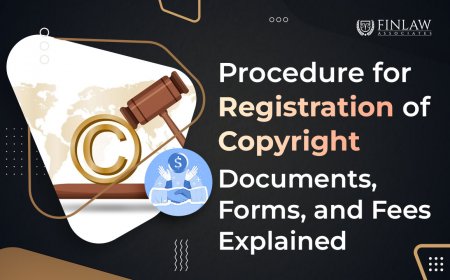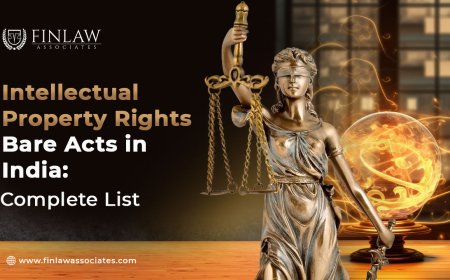Types of Works Eligible for Copyright Registration in India
Learn about the types of works eligible for copyright registration in India and how creators can protect their intellectual property effectively.

Copyright is a vital legal mechanism that protects the intellectual property of creators. In India, the Copyright Act, 1957 governs the protection of original works, granting authors and creators exclusive rights over their creations. While copyright automatically applies to a work the moment it is created, copyright registration provides significant legal advantages such as proof of ownership, enhanced protection in infringement cases, and eligibility for statutory damages.
This article provides an in-depth guide to the types of works eligible for copyright registration in India and highlights why registering your work is crucial in today’s digital and creative economy.
What is Copyright Registration?
Copyright registration is the process of legally recording your creative work with the Copyright Office in India. Registration creates a public record of ownership, making it easier to enforce rights in case of infringement.
Key benefits of copyright registration include:
-
Legal Recognition: Registered works act as prima facie evidence of ownership in Indian courts.
-
Proof of Creation Date: Confirms when the work was created, which is important in disputes.
-
Statutory Remedies: Facilitates claims for damages, injunctions, and other legal remedies.
-
International Protection: Supports protection under international treaties such as the Berne Convention.
Registration can be done online via the Copyright Office portal and is applicable to various categories of works.
1. Literary Works
Literary works are original works expressed in words, numbers, or symbols. This broad category includes:
-
Books (fiction, non-fiction, poetry, educational)
-
Articles, essays, and research papers
-
Scripts for plays, films, and television
-
Song lyrics
-
Software source code and databases
Example: A novelist writing a book on Indian history or a software developer creating a mobile app can apply for copyright registration to protect their literary works.
Under Indian law, software code is explicitly treated as a literary work, providing developers with legal safeguards against unauthorized copying.
2. Musical Works
Musical works consist of compositions, which may or may not include lyrics. This category covers:
-
Compositions for songs or instrumental pieces
-
Musical scores for films or stage performances
-
Background music for advertisements or online content
Important Note: The composition and its recording are protected separately. While the musical composition is a musical work, the sound recording of that composition must be registered independently.
3. Artistic Works
Artistic works include original visual creations. These works are protected to prevent unauthorized copying or reproduction. Examples include:
-
Paintings, sketches, and drawings
-
Sculptures and statues
-
Photographs and digital art
-
Craftworks and handmade designs
-
Architectural designs (buildings, blueprints)
Example: A professional photographer can register their photographs, while a sculptor can protect their original sculpture designs under copyright.
4. Cinematograph Films
Cinematograph films refer to visual recordings captured through any medium. This category includes:
-
Feature films, documentaries, and short films
-
Animations and cartoons
-
Commercials and advertisements
-
Video content for digital platforms
Example: Filmmakers can secure their movies through copyright registration, ensuring that no one reproduces, distributes, or publicly performs the content without authorization.
5. Sound Recordings
Sound recordings protect audio content captured in any format. This includes:
-
Music tracks, albums, and jingles
-
Podcasts and audiobooks
-
Radio or television programs
-
Audio recordings for educational or promotional purposes
Example: A musician releasing an album or a podcaster producing original episodes can register their work to prevent unauthorized use.
6. Dramatic Works
Dramatic works are created for stage or performance. They include:
-
Plays and theatre scripts
-
Choreography and dance compositions
-
Dramatic compositions and performance scripts
Example: A theatre group can register a play script to prevent unauthorized stage performances or adaptations.
7. Computer Programs
Computer programs are legally treated as literary works in India. Protection applies to:
-
Source code
-
Object code
-
Application software and operating systems
Example: An IT company can register a mobile app, ensuring competitors cannot copy or distribute their software without permission.
8. Architectural Works
Architectural works include creative designs and layouts of buildings. Examples include:
-
Building designs and blueprints
-
Floor plans and structural layouts
-
Landscape architecture
Example: An architect designing a unique commercial building can register the architectural plans to protect against duplication.
9. Broadcasts
Broadcasts refer to the electronic transmission of content, including:
-
Television and radio programming
-
Online streaming content
-
News and educational broadcasts
Example: A media company can register its original broadcast content to safeguard against unauthorized retransmission.
10. Derivative Works
Derivative works are adaptations or modifications based on pre-existing works, including:
-
Translations of books
-
Adaptations of novels into movies or plays
-
Remixes of music tracks
Example: Translating a bestselling novel into Hindi or producing a movie adaptation requires separate copyright protection for the derivative work, in addition to respecting the original work’s rights.
Steps for Copyright Registration in India
-
Determine the Category: Identify the type of work (literary, musical, artistic, etc.).
-
Prepare Documents: Include proof of authorship, copies of the work, and identification documents.
-
Submit Application: Apply online through the Copyright Office portal or offline via the Copyright Office in Delhi.
-
Examination Process: The office examines the application and may issue objections or require clarifications.
-
Registration Certificate: Once approved, a registration certificate is issued, providing legal proof of copyright ownership.
Pro Tip: Keep multiple copies of your work with timestamps to strengthen ownership claims before registration is complete.
Importance of Copyright Registration for Creators in India
-
Legal Protection: Registered works provide strong evidence in case of infringement disputes.
-
Financial Security: Protecting creative work allows monetization through licensing, royalties, and partnerships.
-
Brand Reputation: Registered copyrights demonstrate professionalism and legitimacy in business and creative ventures.
-
Global Recognition: Indian copyrights are recognized internationally under agreements such as the Berne Convention and TRIPS.
Whether you are a writer, artist, software developer, or filmmaker, copyright registration ensures that your creative efforts are legally protected and your rights are enforceable.
Conclusion
In the digital age, where content can be easily copied and distributed, protecting intellectual property is more critical than ever. Understanding the types of works eligible for copyright registration in India ensures that creators can secure their rights, prevent unauthorized use, and maintain control over their work. From literary works and music to software and broadcasts, registering your work provides legal certainty, enhances credibility, and opens opportunities for commercial exploitation.
Creators are encouraged to register their works promptly through the Copyright Office to benefit from legal protection, statutory remedies, and public recognition.
What's Your Reaction?















